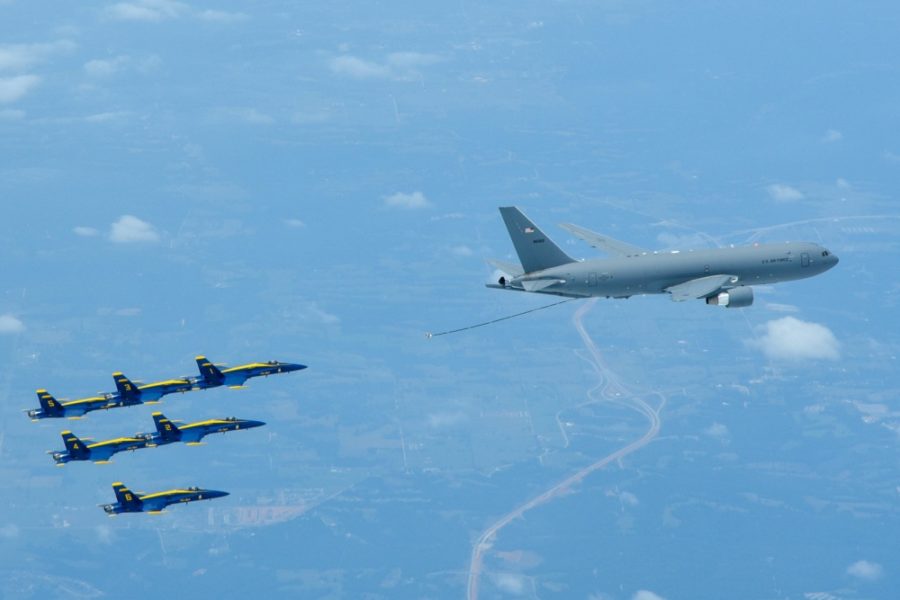Air Mobility Command on July 9 officially opened up the KC-46 to some limited operations, clearing the Pegasus to use its centerline drogue.
The move is an official green light to conduct missions that Pegasus crews have been practicing for months—using the KC-46’s secondary refueling system to pass fuel to aircraft such as Navy F/A-18s. The tanker is still years away from reaching initial operational capability as the Air Force and Boeing work to overhaul the aircraft’s problematic Remote Vision System and refueling boom.
AMC announced earlier this year a roadmap to interim capability releases as the aircraft matures. The steps allow the Pegasus to be tasked by U.S. Transportation Command for some limited missions to free up legacy tankers for real-world tanking missions.
“ICR codifies for operational use what we’re already executing daily as the KC-46A makes progress on its initial operational test and evaluation, or IOT&E, plan,” AMC boss Gen. Jacqueline D. Van Ovost said in a July 12 release. “This is about bringing increased, predictable, and taskable tanker capacity to the joint team today.”
The centerline drogue system is, so far, the most proven capability on the KC-46. In recent months, Pegasus aircraft have fueled F/A-18s during “coronet” deployment missions and in exercises, as well as Navy Blue Angels. Van Ovost said in the release that the decision comes after six months of operational use and programmatic evaluation.
By the end of June, KC-46s had flown about 5,000 sorties, with more than 2,500 missions executed in 2021 alone, according to an AMC release. The tanker has made more than 19,700 positive contacts using both its hose and drogue and boom systems and offloaded more than 21.8 million pounds of fuel.
“Under this new approach, if AMC is tasked to provide AR support for an operational coronet mission to move F-18s overseas or an operational B-52 mission, the KC-46 is on the table, which frees up KC-135s and KC-10s to execute other combatant command deployments that the KC-46A is presently unable to support with its existing deficiencies,” Van Ovost said in announcing the plan in February.
The KC-46 has been cleared for months to use the system without restrictions. The aircraft can pass fuel, with other varying restrictions, to B-52s, C-17s, F-15s, F-16s, F-35As, HC/MC-130Js, other KC-46s, E-3Gs, C-5Ms, RC/TC-135s, F-22s, and B-1Bs. In the coming months, the aircraft is expected to receive limited aerial refueling certifications and clearances for CV/MV-22s, E-8s, B-2s, and P-8s.
While the ICR plan will proceed in the coming months to free up additional missions, there are still strict limitations. No KC-46s will deploy overseas for combat deployments, for example, until they are deemed operationally capable with the RVS and refueling boom.
The Air Force and Boeing in late June said they were addressing two previously unannounced Category 1 deficiencies impacting the aircraft’s receptacle drain line tubes and its Flight Management System. These are in addition to four other long-standing Category 1 deficiencies relating to the RVS and “stiff” refueling boom that requires an actuator redesign. Van Ovost in May said the RVS 2.0 redesign was undergoing its preliminary design review with positive initial feedback.
